Palmer Station Timeline
2005-present
Summer 2005-06
Terralab (IMS) building completed and occupied
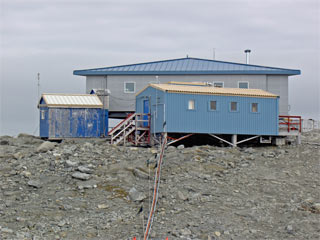 Here is a January 2006 view of the new building, partially hidden behind CAF and T5 which it replaces...this photo is by Dr. Gregory Zaar of the Keeling air sampling group at UCSD. They have a page of historical Palmer photos here.
Here is a January 2006 view of the new building, partially hidden behind CAF and T5 which it replaces...this photo is by Dr. Gregory Zaar of the Keeling air sampling group at UCSD. They have a page of historical Palmer photos here.
(photos of the Terralab building construction are here)
Winter 2006
Manager: Brett Pickering; population 15-17 (list and photos)
Science project installation in the new Terralab building continues
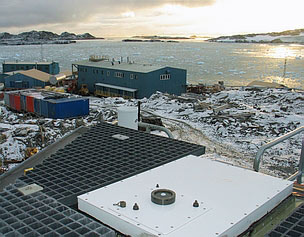
One of these was the spectroradiometer, seen here on the Terralab roof after being installed in April. It had been on the roof of T-5...I was involved with the original project installation in the roof of the Clean Air vestibule in 1988. This photo is from the Biospherical Instruments project page.
Marine tech Joshua Spillane disappears from the Laurence M. Gould
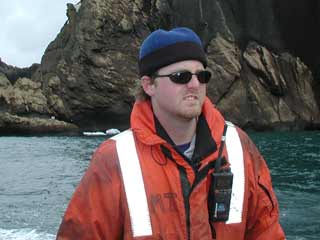
Veteran marine tech Joshua Spillane disappeared, apparently overboard, on 17 April LMG transit north to PA, and has been declared dead. Here is more information from RPSC/USAP and a NSF press statement. The photo at left shows him operating a Zodiac at Deception Island in 2000, it is an NSF photo included with the above RPSC/USAP information page.
One of the 1988 vintage 3406 generators in the power plant replaced with a similar new model
Accidental CO2 discharge in the power plant produces some excitement and a brief power outage (but no harm or injury) on 16 May during the annual PM when an empty bottle was being replaced
Summer 2006-07
First appearance of the "glider" at Palmer Station
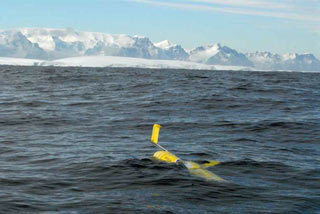
This Webb-Slocum glider, or UAV (underwater autonomous vehicle), was first deployed by Rutgers LTER team member Clayton Jones of Webb Research (more info and photos) from the LMG on 7 January (left) just before the vessel departed the station for an LTER cruise. The glider operates by adjusting buoyancy so that it bobs up and down fore-and-aft while submerged, thus generating forward propulsion. It can surface (as seen here) so that its antenna can transmit position and data to the satellites. On this particular trip it reported a slow leak shortly after deployment, so it was recovered, repaired, and redeployed a day or two later. It traveled more than 400 km down the Peninsula and was recovered at the end of the month. This photo and information is taken from the 07-13 January LMG sitrep; here's an Antarctic Sun article (PDF) with details and a photo of the launch.
Winter 2007
Manager: Eric Pohlman; population 16 (list and photos)
Time capsule buried just outside the boat shop (24 July).
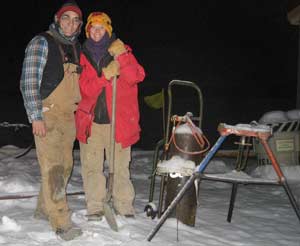
Plumbers Jon and Janice Martin are good people--I wintered with them at Pole in 2005. Anyway...there was a need for a buried pipe between biolab and the boathouse, so this became an excuse to bury a time capsule. No photo documentation of the actual burial, but Dave Minor told me it was buried toward the southeast corner of the boathouse, about 2 to 3 feet down. The capsule itself was a 4x6 pipe containing photos and mementos. Dave, the assistant winter lab manager, shared the photos which were placed in the time capsule on this Picasa page.
The Nathaniel B. Palmer makes an unscheduled call (6 September) after a serious lab fire.
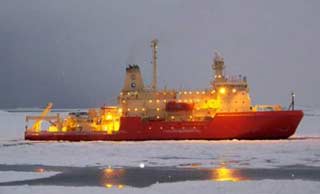 The NBP had just begun a scheduled 2-month cruise in the Bellingshausen/Amundsen Seas as part of the SIMBA project, studying sea ice properties, when a serious fire was started by one of the lab refrigerators which contained 3 liters of flammable acetone. No injuries, but much soot contamination and email/network issues. The vessel visited Palmer to refill SCBA bottles and reestablish comms, and returned to Punta Arenas for cleaning of the damaged areas before the cruise continued. The photo at left is from the diary of Sarah Anderson, a PolarTREC teacher working with the SIMBA project. This diary page she posted (and others) describe/depict the fire and its aftermath. More photos are on the project website.
The NBP had just begun a scheduled 2-month cruise in the Bellingshausen/Amundsen Seas as part of the SIMBA project, studying sea ice properties, when a serious fire was started by one of the lab refrigerators which contained 3 liters of flammable acetone. No injuries, but much soot contamination and email/network issues. The vessel visited Palmer to refill SCBA bottles and reestablish comms, and returned to Punta Arenas for cleaning of the damaged areas before the cruise continued. The photo at left is from the diary of Sarah Anderson, a PolarTREC teacher working with the SIMBA project. This diary page she posted (and others) describe/depict the fire and its aftermath. More photos are on the project website.Summer 2007-08
Amsler Island named after long-time researchers Maggie and Chuck (October)
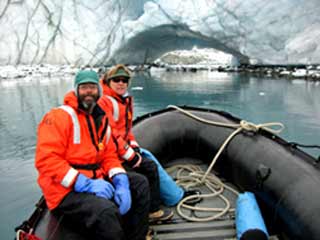 The 1.3-mile long strip of island lies between Arthur Harbor and Loudwater Cove...until recently this was a peninsula until the receding glacier exposed open water connecting the harbor and the cove. It includes Norsel Point as well as the site of BAS Base and Old Palmer.
The 1.3-mile long strip of island lies between Arthur Harbor and Loudwater Cove...until recently this was a peninsula until the receding glacier exposed open water connecting the harbor and the cove. It includes Norsel Point as well as the site of BAS Base and Old Palmer.Chuck Amsler, a marine algal ecophysiologist and chemical ecologist, is an expert on Antarctic macroalgae (seaweeds). He's made 11 trips to the ice, seven of them (the first in 1985-96) to Palmer Station. Wife Maggie is an invertebrate zoologist, she's made 16 ventures to Palmer Station, the first in 1979-80. The two of them have completed more than 500 Antarctic research dives; their most recent trip to Palmer concluded in June 2008. Their photo at left came from the original version of this University of Alabama-Birmingham (UAB) press release; here is a map.
MS Explorer sinks (23 November)
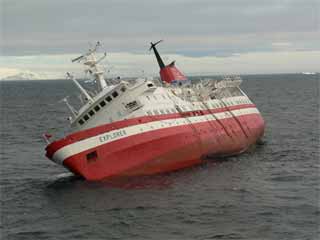 The 250-foot ship hit an unidentified underwater object at about 2345 local time (GMT-3) on 22 November, at 62°S- 57°W, and quickly started filling with water from a reported 4x10 inch gash in the hull. By 0430 the 91 passengers, 9 guides and 54 crew had been evacuated to lifeboats. They were picked up by the Norwegian cruise ship MS Nodnorge and transported to KGI, while the Explorer sank around 1530 in 1300m of water.
The 250-foot ship hit an unidentified underwater object at about 2345 local time (GMT-3) on 22 November, at 62°S- 57°W, and quickly started filling with water from a reported 4x10 inch gash in the hull. By 0430 the 91 passengers, 9 guides and 54 crew had been evacuated to lifeboats. They were picked up by the Norwegian cruise ship MS Nodnorge and transported to KGI, while the Explorer sank around 1530 in 1300m of water.The ice-strengthened vessel, originally built in 1969 as the Lindblad Explorer, was the first ship specifically constructed to bring tourists to Antarctic waters. As such it made many visits to Palmer Station beginning in the early 1970s. For more details on the incident, here are 3 reports presented at the June 2008 Antarctic Treaty meeting (ATCM) in Kiev: an official investigation by Liberia (the flag state of the vessel); a report on Chilean involvement in the search and rescue; and a Chilean report on the environmental impacts and response. (Photo from Reinhard Jahn, Creative Commons license). While not noted in the above reports, I understand that a major factor in the sinking was that there were no check valves in the toilet waste system, allowing water to flow from flooded to other sealed compartments. The toilet overflows were reported by passengers.
Winter 2008
Manager: Eric Pohlman; population 20-24 (list and photos)
Bill Detrich (and a large team of researchers from his Northeastern University lab) shows up in April after a 5-year absence, to continue studying Antarctic fishes (his web page).
First documented marathon, the "Antarctic Icefish Mid-Winters Day Marathon," held on 21 June. It was organized by 63-year-old researcher John Lostlethwait, and network engineer Paul Queior (age 29) also competed. It was mostly run on top of the glacier...the course record was 6:45.
LTER researcher Kristen Myers successfully medevaced (26 August) by the LMG and flown to PA by a Chilean Twin Otter.
Summer 2008-09
The "gliders" show up again...
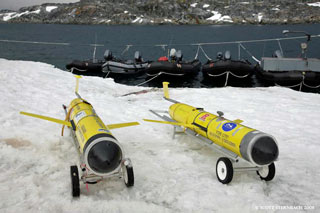 Perhaps otherwise known as autonomous underwater vehicles (AUV's), these vehicles, technically known as Webb Research Slocum gliders, were brought by the Rutgers University LTER team.
This photo appears in the November 2008 LTER science sitrep; it is © Scott Sternbach, who was on station between September and November on an Artists and Writers project titled "Antarctica in Black and White." While the photo at left is in color, he documented the station personnel and their activities in monochrome, using a large-format film camera, on his web site. Here's an Antarctic Sun article about his visit, along with a portfolio sample, these views of 2008 winterovers Chris Seliga and Sean Bonnette.
Perhaps otherwise known as autonomous underwater vehicles (AUV's), these vehicles, technically known as Webb Research Slocum gliders, were brought by the Rutgers University LTER team.
This photo appears in the November 2008 LTER science sitrep; it is © Scott Sternbach, who was on station between September and November on an Artists and Writers project titled "Antarctica in Black and White." While the photo at left is in color, he documented the station personnel and their activities in monochrome, using a large-format film camera, on his web site. Here's an Antarctic Sun article about his visit, along with a portfolio sample, these views of 2008 winterovers Chris Seliga and Sean Bonnette.
...as did the Fuerza Aérea de Chile (Chilean Air Force) with a Twin Otter landing on the glacier (27 February) for an urgent medevac of one of the science support staff.
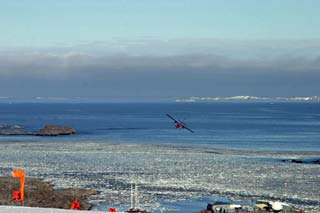 The aircraft flew to Eduardo Frei (the Chilean base on King George Island) where the patient was transferred to another aircraft (a C-130 perhaps) for the flight to Punta Arenas. They fortunately responded to treatment and recovered quickly once in hospital. What's of interest here is not the medevac, but rather the fine documentation of the landing and takeoff in this YouTube video by Paul Queior, with footage from Bob DeValentino, Kyle Hoppe, Dan Whiteley, Jon Brack, and Paul Queior. The first part of the video is a February 2010 LARISSA support flight by a BAS aircraft; the 2009 video is amazing in part because it shows all those runway markers. This photo is courtesy of Elizabeth Leonardis, it appeared on her old blog.
The aircraft flew to Eduardo Frei (the Chilean base on King George Island) where the patient was transferred to another aircraft (a C-130 perhaps) for the flight to Punta Arenas. They fortunately responded to treatment and recovered quickly once in hospital. What's of interest here is not the medevac, but rather the fine documentation of the landing and takeoff in this YouTube video by Paul Queior, with footage from Bob DeValentino, Kyle Hoppe, Dan Whiteley, Jon Brack, and Paul Queior. The first part of the video is a February 2010 LARISSA support flight by a BAS aircraft; the 2009 video is amazing in part because it shows all those runway markers. This photo is courtesy of Elizabeth Leonardis, it appeared on her old blog.
Winter 2009
Manager: Ken Keenan; May population 30/August population 16 (list and photos)
Hugo Island AWS reinstalled (April)
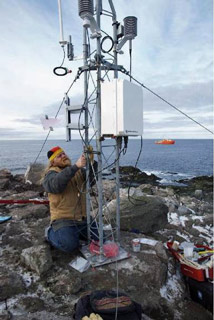
The site was formerly named Santa Claus Island...after some failed efforts it was replaced in April 2009, here you see Kevin Pedigo, LMGould computer/instrument specialist, doing the installation (2009 Palmer Area Users Committee documentation).
Former USAP research vessel Polar Duke decommissioned...reassigned...repainted (?)
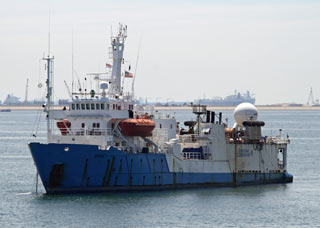
The latter history of this vessel is a bit confusing (sorry). Briefly...after the USAP contract ended, the owners Rieber Shipping converted it into a seismic research vessel and renamed it the Duke. It was assigned to a Rieber subsidiary, Exploration Resources, which was subsequently spun off...yada yada yada. The gory details including links to such obscure info as SEC 6-K data, annual reports, a current data sheet, and an older photo of the still-red-hulled Duke in Wellington Harbor...are here.
Oprah Winfrey show segment presented from Palmer Station (aired 21 May)

The taped show was part of a "Skype Around the World" series that Oprah was presenting. Interestingly, the use of Skype is normally verboten at USAP stations and facilities, so the IT and comms folks had some work to do to get things set up. Fortunately, weather the day of the taping was good, with clear skies, appropriate for discussion of global warming. Here are two pages from the Skype section of the program web site...one showing Neal Sheibe...and another showing Bruce Sidell. Sadly, this was Bruce's last trip to Palmer Station...he passed away less than 2 years later in February 2011 (obituary). The page image at left is courtesy of Neal Scheibe, he has more photos of the event on this blog page.
Summer 2009-10
Rec hut rebuilt from the foundation up
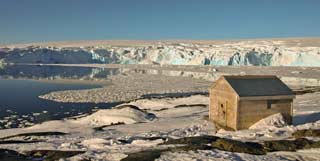
The original hut had been built here by Thumper during the 1990 winter; twenty years on, it suffered from a severe mold problem and was deemed unsafe for overnight use. So approval was obtained to rebuild it (more information and photos).
NASA "Operation Icebridge" DC-8 flight overflies the station
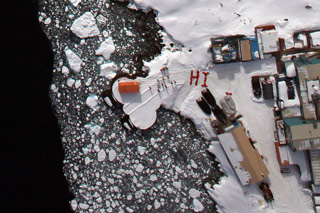
The project is a six-year program to obtain three-dimensional views of Arctic and Antarctic ice sheets, ice shelves and sea ice. In this photo, Palmer residents in float coats document their presence (NASA photo by John Arvesen). The continuing 6-year project overflew Pole in November 2010. During the boreal summer the team operates over the Arctic, usually based in Kanger or Thule, Greenland.
First new area penguin rookery in 10 years observed...gentoo penguins on an unnamed island near Dream Island
Astronaut Neil Armstrong drops by for a visit
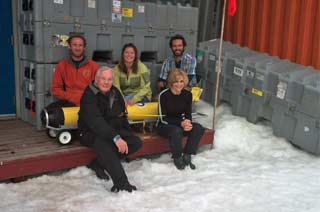 Neil and his wife Carol (in the front row) were aboard the National Geographic Explorer when it called at Palmer Station the weekend of 17-18 November. Palmer folks were invited aboard the vessel for Neil's lecture, which linked his space exploration with both historic and current Antarctic exploration. In the back row of the photo are Brian Gaas, Tina Haskins, and Alex Kahl of the Rutgers LTER project...they got to talk to Carol and Neil about their project, and they showed them their gliders. Neil Armstrong, who passed away on 25 August 2012, had previously visited the North Pole in April 1985, the group included Sir Edmund Hillary, son Peter Hillary, and Mike Dunn (Mike would later be first to climb the seven summits. This 2005 report is by Pat Morrow, the leader of the first Canadian expedition to climb Everest; also here's an August 2012 article from the Sydney Morning Herald. The Palmer Station photo is from this archived Rutgers LTER blog post; here is another photo of Neil and his wife from Bob Farrell.
Neil and his wife Carol (in the front row) were aboard the National Geographic Explorer when it called at Palmer Station the weekend of 17-18 November. Palmer folks were invited aboard the vessel for Neil's lecture, which linked his space exploration with both historic and current Antarctic exploration. In the back row of the photo are Brian Gaas, Tina Haskins, and Alex Kahl of the Rutgers LTER project...they got to talk to Carol and Neil about their project, and they showed them their gliders. Neil Armstrong, who passed away on 25 August 2012, had previously visited the North Pole in April 1985, the group included Sir Edmund Hillary, son Peter Hillary, and Mike Dunn (Mike would later be first to climb the seven summits. This 2005 report is by Pat Morrow, the leader of the first Canadian expedition to climb Everest; also here's an August 2012 article from the Sydney Morning Herald. The Palmer Station photo is from this archived Rutgers LTER blog post; here is another photo of Neil and his wife from Bob Farrell.
Divers visit to repair the pier
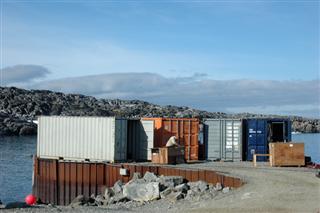 The diving team of Rob Robbins, Steve Rupp and Travis Matoush visited in the second year of the project to patch holes in the sheet pile by welding patches underwater. Rather than dry suits usually worn by science divers, the team wore modified wet suits which had a hose that supplied 105° warm water from the surface, to allow for longer dives. The holes in the sheet pile were allowing the fill dirt/rocks to spill out, creating sink holes on the surface. In the photo at left (by Peter Rejcek), Travis Matoush is cutting a steel patch for one of the holes. This Antarctic Sun article has the story and more pictures. Oh yes, there still is an $8 million project out there to replace the pier.
The diving team of Rob Robbins, Steve Rupp and Travis Matoush visited in the second year of the project to patch holes in the sheet pile by welding patches underwater. Rather than dry suits usually worn by science divers, the team wore modified wet suits which had a hose that supplied 105° warm water from the surface, to allow for longer dives. The holes in the sheet pile were allowing the fill dirt/rocks to spill out, creating sink holes on the surface. In the photo at left (by Peter Rejcek), Travis Matoush is cutting a steel patch for one of the holes. This Antarctic Sun article has the story and more pictures. Oh yes, there still is an $8 million project out there to replace the pier.Twin Otter lands on the glacier bringing LARISSA project team members (18 February)
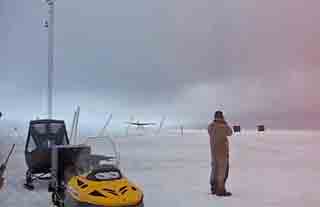 Glacier aircraft operations are rare, but they do happen-- what is impressive here is that it was well documented on video. The Rothera-based Twin Otter was supporting LARISSA, a multiyear project studying the Larsen Ice Shelf (Hamilton College web site/blog and Ohio State/Byrd Polar Research Center blog). Ted Scambos and other team members were unable to rendezvous with the Nathanial B. Palmer due to ice conditions, so the Twin Otter flew them to Palmer Station, from where they were transferred by the Laurence M. Gould to the NBP. This operation was documented in the first part of this YouTube video (left, a frame from the video) by Paul Queior et al; here is Ted Scambos' blog post about the flight.
Glacier aircraft operations are rare, but they do happen-- what is impressive here is that it was well documented on video. The Rothera-based Twin Otter was supporting LARISSA, a multiyear project studying the Larsen Ice Shelf (Hamilton College web site/blog and Ohio State/Byrd Polar Research Center blog). Ted Scambos and other team members were unable to rendezvous with the Nathanial B. Palmer due to ice conditions, so the Twin Otter flew them to Palmer Station, from where they were transferred by the Laurence M. Gould to the NBP. This operation was documented in the first part of this YouTube video (left, a frame from the video) by Paul Queior et al; here is Ted Scambos' blog post about the flight.
Winter 2010
Manager: Lisa Trotter; population 18 (list and photos)
Dennis Calhoun shows up to give one of my now-ancient 3406B generators (#2) a rebuild; #1 was scheduled for early summer 2010-11.
Interferometer room constructed in Terralab.
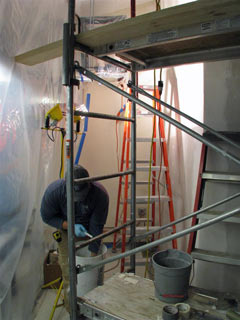
The room was constructed in the center of Terralab...a darkroom and an instrument platform on the roof above (more information and photos).
Directional signpost erected
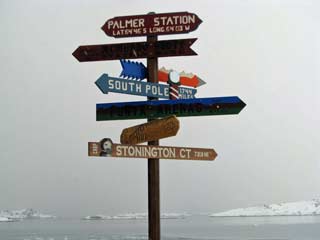
The signpost, constructed in a traditional style common at inland stations in the earlier days of the Antarctic program, is a first of its kind at Palmer Station (more information).
Summer 2010-11
Generator rework completed--#1 repaired restoring full load capacity...then Gen #2 was rebuilt.
New boat ramp added
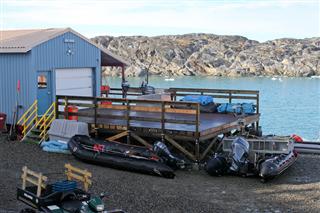
Not exactly a ramp...but a large deck platform in front of the boathouse, allowing storage for more Zodiacs than the old small ramp, and better crane/forklift access (photo courtesy of Brian Nelson).
Maine biologist and long-time Palmer researcher Bruce Sidell passes away (8 February)
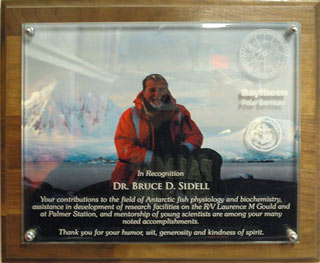
In commemoration of his long-time work at Palmer and on the research vessels, this plaque was installed in the main entrance/float coat vestibule (An identical plaque has also been installed on the Laurence M. Gould.) Here's more information and his obituary.
Winter 2011
Manager: Perri Barbour; population 15 (list and photos)
A rare visitor...an emperor penguin takes up residence in the backyard (March). Global warming? Has one been seen here before? Well, they ARE getting around...another one turned up in New Zealand in June 2011.
100-foot antenna tower removed from Bonaparte Point (April).
VLF antenna relocated (April).
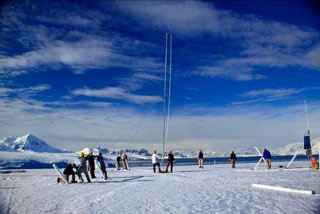
This was another major project for the antenna riggers' visit...not the first time that the tower has had to be moved to a safer spot because of glacier melting and the encroaching of crevasses (photo by David Strauss).
New Wisconsin project shows up to study land formations and monitor soil and permafrost temperatures at Palmer, and Deception and Livingston Islands (Dr. James Bockheim, PI).
Winter projects...first phase of aquarium renovations...as well as a new backbar!
DRI and USF researchers arrive in late August for well-documented research.
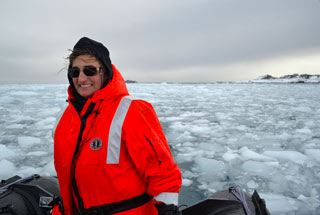 The project studied plankton responses to the changing seasons...DRI produced an extremely detailed web site with field reports, interviews, science data, and lots of video. Many of the interviews with the winterovers included videos and lots of detail about the station. DRI was conducting research in Antarctica back during my first winter in 1977. The current project involved lots of boating and water sampling...at left is one of the principal investigators, Deneb Karentz. I met her when she first visited Palmer in the late 80's.
The project studied plankton responses to the changing seasons...DRI produced an extremely detailed web site with field reports, interviews, science data, and lots of video. Many of the interviews with the winterovers included videos and lots of detail about the station. DRI was conducting research in Antarctica back during my first winter in 1977. The current project involved lots of boating and water sampling...at left is one of the principal investigators, Deneb Karentz. I met her when she first visited Palmer in the late 80's.
Fast ice strong enough for foot travel surrounds the station in September/October for the first time in 10 years. Pack ice was severe off and on through November.
Summer 2011-12
Yacht Spirit of Sydney calls (December)...
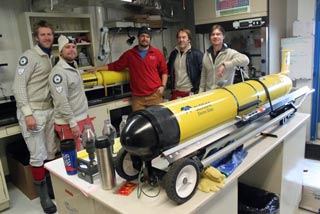
One of the crew members on this "Spirit of Amundsen" expedition was Jørgen Amundsen, the great-grand nephew of Roald. Their venture included skiing on the Peninsula, and climbing an unnamed peak on 14 December, the centenary of Amundsen's arrival at Pole. At left, some of the expedition members including Amundsen are taking a look at the gliders in the Palmer lab, from this Rutgers blog post by Travis Miles (wearing red).
Rutgers team sends one of their gliders (AUV's) from Palmer to Rothera, collecting data along the way. The trip took about 60 days (Rutgers blog with photos and data).
Fuel tanks repainted black after major cleaning effort.
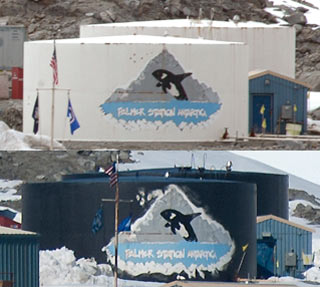
The project was developed because of long-term problems with waxing and separating fuel in one of the 250,000 gallon tanks, so passive solar heating was invoked to keep the fuel from gunking up. Later in the summer, a team of fuelies from McMurdo showed up to clean the tank and get it ready for fresh fuel. At the time the fuel used by Palmer Station was a blend of 60% marine diesel oil (MDO) and 40% Jet-A (in the late 80's when I was involved, it was DFM). The project of course generated many drums of waste which were shipped out in July 2012.
At left are before and after photos of the fuel tanks; more information, photo links, the larger images, and credits are here.
February visitors included Al Gore and other members of the Climate Reality Project, traveling on the National Geographic Explorer (blog post by Al Gore)...
...as well as the Blue Ribbon Panel.
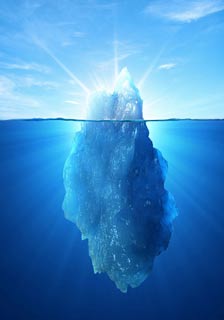 That independent committee had been tasked by the White House OSTP and NSF to assess the logistics and similar requirements for the USAP to pursue science and diplomacy in Antarctica (panel charter, review requirements and meeting documents). After visiting all 3 of the USAP Antarctic stations and other facilities, the panel report was issued on 23 July 2012 (Antarctic Sun article). The general recommendations included upgrading facilities master plans along with capital projects budgeting, pursuing new vessels for research and icebreaking support, improving energy efficiency, reducing contractor personnel requirements, and replacing MAPCON (!) Some of the recommendations pertinent to Palmer included: modify or replace the pier (not the only recommendation that was being studied when I first became involved with Palmer facilities in 1986), reconstruct the boat ramp, provide fire suppression in the carpenter shop, consolidate hazardous materials into one storage area, move the power generators out of berthing buildings, move the galley away from berthing areas, and procure RIBs to enhance boating safety and allow an expanded boating radius. The executive summary and the full report are available here. The cover image on the report is at left...it is NOT an actual (or Photoshopped) image of an actual iceberg...rather it was created by NSF illustrator Zina Deretsky (more information and video statements by panel members).
That independent committee had been tasked by the White House OSTP and NSF to assess the logistics and similar requirements for the USAP to pursue science and diplomacy in Antarctica (panel charter, review requirements and meeting documents). After visiting all 3 of the USAP Antarctic stations and other facilities, the panel report was issued on 23 July 2012 (Antarctic Sun article). The general recommendations included upgrading facilities master plans along with capital projects budgeting, pursuing new vessels for research and icebreaking support, improving energy efficiency, reducing contractor personnel requirements, and replacing MAPCON (!) Some of the recommendations pertinent to Palmer included: modify or replace the pier (not the only recommendation that was being studied when I first became involved with Palmer facilities in 1986), reconstruct the boat ramp, provide fire suppression in the carpenter shop, consolidate hazardous materials into one storage area, move the power generators out of berthing buildings, move the galley away from berthing areas, and procure RIBs to enhance boating safety and allow an expanded boating radius. The executive summary and the full report are available here. The cover image on the report is at left...it is NOT an actual (or Photoshopped) image of an actual iceberg...rather it was created by NSF illustrator Zina Deretsky (more information and video statements by panel members).
Fire destroys Brazil's Comandante Ferraz station on KGI, killing 2 Navy personnel (25 February)
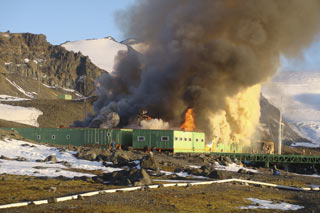 It started in the power plant shortly after midnight on Saturday morning and essentially destroyed the base, which is in Admiralty Bay only a few miles from Poland's Arctowski station and the Copacabana penguin research site. 65 people were on station at the time. A third Navy staff member was injured. Firefighting efforts were hampered by bad weather. People from Arctowski assisted with logistics and evacuation. Here's a Daily Mail (UK) article with more photos as well as information about the 10,000l diesel barge that had sunk nearby in December. The photo at left is from the public news agency Agência Brasil.
It started in the power plant shortly after midnight on Saturday morning and essentially destroyed the base, which is in Admiralty Bay only a few miles from Poland's Arctowski station and the Copacabana penguin research site. 65 people were on station at the time. A third Navy staff member was injured. Firefighting efforts were hampered by bad weather. People from Arctowski assisted with logistics and evacuation. Here's a Daily Mail (UK) article with more photos as well as information about the 10,000l diesel barge that had sunk nearby in December. The photo at left is from the public news agency Agência Brasil. Winter 2012
Manager: Ken Keenan; population 29/19 (list and photos)
USAP support contract shifts from RPSC to Lockheed-Martin (1 April).
 The office facility in Centennial, Colorado (Denver suburb) remained the same, but here's a photo (from Elaine Hood) of the new sign out front. Here's my description of the long and delayed process of the contract bidding and award, a complete history of the NSF contracting process from the IGY days to the present, and a list of the expanded group of subcontractors now involved with the USAP. Of special note, the logistics contractor DAMCO is the new agent in Punta Arenas, replacing AGUNSA, and some of the facilities have been relocated.
The office facility in Centennial, Colorado (Denver suburb) remained the same, but here's a photo (from Elaine Hood) of the new sign out front. Here's my description of the long and delayed process of the contract bidding and award, a complete history of the NSF contracting process from the IGY days to the present, and a list of the expanded group of subcontractors now involved with the USAP. Of special note, the logistics contractor DAMCO is the new agent in Punta Arenas, replacing AGUNSA, and some of the facilities have been relocated.Woods Hole thermosalinograph and associated webcam shut off after camera and instrumentation failure (July). (It had been installed in 2005).
Second phase of aquarium renovation...including concealed electrical, new wall coverings...as well as reorganization of GWR heavy shop and storage area renovation/reorganization.
Summer 2012-13
More fenders (bumpers) added to the pier
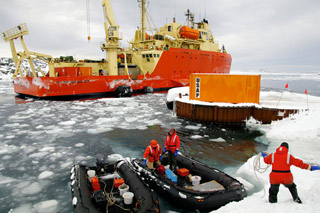 The LMG made its biennial trip to Louisiana during the 2012 winter...to transport hazardous waste and also to get some maintenance and drydock time. In drydock, a dent was found from the infamous ledge near the pier. So...when the LMG got back to PA, a hunt was conducted for more fenders. Between the warehouse and a local supplier, two were located...a large one and a small one...and the LMG brought them down on the second cruise in October. In the photo (from Sean Bonnette) you see that they were attached alongside the LMG before it docked; they then were attached to the pier. But the small one was too small...so another bigger one was brought down on the October cruise (more info/history/photos).
The LMG made its biennial trip to Louisiana during the 2012 winter...to transport hazardous waste and also to get some maintenance and drydock time. In drydock, a dent was found from the infamous ledge near the pier. So...when the LMG got back to PA, a hunt was conducted for more fenders. Between the warehouse and a local supplier, two were located...a large one and a small one...and the LMG brought them down on the second cruise in October. In the photo (from Sean Bonnette) you see that they were attached alongside the LMG before it docked; they then were attached to the pier. But the small one was too small...so another bigger one was brought down on the October cruise (more info/history/photos).And more and different ships show up...including the Le Boreal, a luxury 466-foot cruise ship operated by Abercrombie & Kent. It made two voyages of interest to the Peninsula; on this trip (9-18 December) it called at Palmer on the 15th (photo from Glenn Grant).
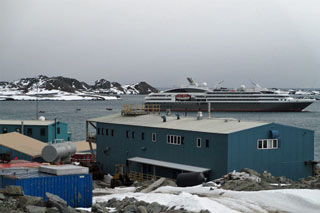 This was a "philanthropic cruise," with UAB scientist Jim McClintock bringing a penguin webcam which has been set up on Torgersen Island. Here's Jim's UAB blog post. Also aboard was Nabisco's "Oreo Man"--on a promotional visit (news coverage)--he wasn't allowed to come ashore or film, but the station did receive 5,000 Oreos. On its previous Antarctic cruise (29 November-8 December) the vessel did not call at Palmer, but it did visit Vernadsky. Aboard was a wildlife photographic team which was producing the cover story of the special issue for a major sports magazine. Here is a SI video featuring Kate Upton's 'swimsuit issue' visit to the Antarctic Peninsula...and also an interview she did for the Today show and a Bloomberg video which includes penguins.
This was a "philanthropic cruise," with UAB scientist Jim McClintock bringing a penguin webcam which has been set up on Torgersen Island. Here's Jim's UAB blog post. Also aboard was Nabisco's "Oreo Man"--on a promotional visit (news coverage)--he wasn't allowed to come ashore or film, but the station did receive 5,000 Oreos. On its previous Antarctic cruise (29 November-8 December) the vessel did not call at Palmer, but it did visit Vernadsky. Aboard was a wildlife photographic team which was producing the cover story of the special issue for a major sports magazine. Here is a SI video featuring Kate Upton's 'swimsuit issue' visit to the Antarctic Peninsula...and also an interview she did for the Today show and a Bloomberg video which includes penguins.
The R/V Point Sur, based at the Moss Landing Marine Laboratories, shows up at the end of January...
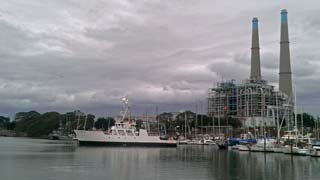 ...and maxed out the station population at 54...reportedly the most people living on station since the Bahia Paraiso sank and left about 300 folks camped out in life raft tents. The visit of this 135-foot NSF-owned vessel--part of the UNOLS fleet--was an experiment to test Antarctic capabilities of smaller, less expensive vessels. The photo at left is of their 5 December 2012 departure; the Moss Landing power plant, where I worked for a time, is in the background (more information and links).The photo at left below shows the Point Sur docked at the Palmer pier.
...and maxed out the station population at 54...reportedly the most people living on station since the Bahia Paraiso sank and left about 300 folks camped out in life raft tents. The visit of this 135-foot NSF-owned vessel--part of the UNOLS fleet--was an experiment to test Antarctic capabilities of smaller, less expensive vessels. The photo at left is of their 5 December 2012 departure; the Moss Landing power plant, where I worked for a time, is in the background (more information and links).The photo at left below shows the Point Sur docked at the Palmer pier.New Zodiac dock constructed/installed (January) (photo from Sean Bonnette).
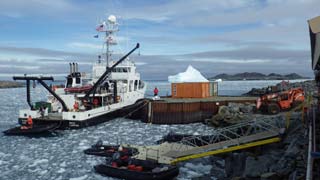 This was the first completed infrastructure improvement mentioned in NSF's response to the BRP recommendations that were released on 21 March. Consisting of several floating plastic sections, it was installed below some existing stairs next to the boathouse... allowing easier/ safer Zodiac access. Still to come... a boat ramp to facilitate getting the boats in and out of the water (see below). Future plans include procurement of
RIBs and the pier replacement. Here's the 22 March Antarctic Sun article; here is another photo of the dock (from the BRP report) by Rebecca Shoop/Bob Farrell.
This was the first completed infrastructure improvement mentioned in NSF's response to the BRP recommendations that were released on 21 March. Consisting of several floating plastic sections, it was installed below some existing stairs next to the boathouse... allowing easier/ safer Zodiac access. Still to come... a boat ramp to facilitate getting the boats in and out of the water (see below). Future plans include procurement of
RIBs and the pier replacement. Here's the 22 March Antarctic Sun article; here is another photo of the dock (from the BRP report) by Rebecca Shoop/Bob Farrell.Winter 2013
Manager: Bob DeValentino; population 22 (list and photos)
New small boat ramp partially constructed.
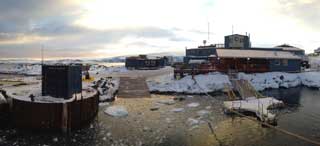 This photo shows the new wood boat ramp and the small boat pier at the end of the early winter 2013 construction season. The LMG departure was delayed for 5 days to get more work done, but there are still 4 more planks to be installed at the top and at the bottom of this ramp...as well as the right half of the ramp. Here's a project drawing of the ramp and small boat pier (from the pier reconstruction solicitation--see below) (1 July photo by Bob DeValentino from the USAP Antarctic Photo Library).
This photo shows the new wood boat ramp and the small boat pier at the end of the early winter 2013 construction season. The LMG departure was delayed for 5 days to get more work done, but there are still 4 more planks to be installed at the top and at the bottom of this ramp...as well as the right half of the ramp. Here's a project drawing of the ramp and small boat pier (from the pier reconstruction solicitation--see below) (1 July photo by Bob DeValentino from the USAP Antarctic Photo Library).
Solicitation issued for pier reconstruction (27 June).
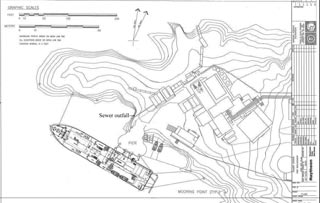 This interest solicitation (with responses due by 23 August 2013) seeks preliminary input on reconstruction or replacement of the Palmer pier. At left, a diagram of the Laurence M. Gould docked at the existing pier...which was built in 1967. The original pier was built to support the much smaller R/V Hero; when that vessel was replaced with the Polar Duke in the mid-1980's, the first study was done to provide an appropriate pier. That study result (which I was slightly involved with) was a proposal for a jackup pier outboard of those sheet piles, but that study never went anywhere. The alternative was those black fenders, which are still there today.
This interest solicitation (with responses due by 23 August 2013) seeks preliminary input on reconstruction or replacement of the Palmer pier. At left, a diagram of the Laurence M. Gould docked at the existing pier...which was built in 1967. The original pier was built to support the much smaller R/V Hero; when that vessel was replaced with the Polar Duke in the mid-1980's, the first study was done to provide an appropriate pier. That study result (which I was slightly involved with) was a proposal for a jackup pier outboard of those sheet piles, but that study never went anywhere. The alternative was those black fenders, which are still there today.Summer 2013-14
Summer science almost cancelled by the US Government shutdown.
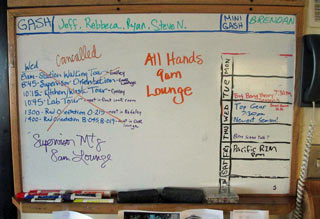 The Laurence M. Gould had arrived on 8 October, just in time for all of the scientists on board to be told to stay on the vessel and not unpack cargo...and get ready to head back north on 17 October. That iconic galley whiteboard has depicted much over the years, but the 9 October announcement (left) is perhaps one of the saddest. The LMG carried down a big load of food and fuel which still needed to be offloaded, but after that, the labs were to be mothballed and a bunch of science cargo was to be loaded for the trip north...along with the scientists who had been intending to use it...
The Laurence M. Gould had arrived on 8 October, just in time for all of the scientists on board to be told to stay on the vessel and not unpack cargo...and get ready to head back north on 17 October. That iconic galley whiteboard has depicted much over the years, but the 9 October announcement (left) is perhaps one of the saddest. The LMG carried down a big load of food and fuel which still needed to be offloaded, but after that, the labs were to be mothballed and a bunch of science cargo was to be loaded for the trip north...along with the scientists who had been intending to use it......but there was a last-minute reprieve.
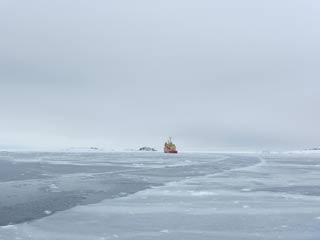
Fortunately the shutdown ended less than 24 hours before that scheduled Laurence M. Gould departure...so that science cargo was offloaded, the scientists moved ashore, and on 18 October it headed north leaving the scientists behind at Palmer to begin their summer research (left, photo from MIT-WHOI grad student Jamie Collins of the LMG departure). and a 20 October Toronto Star article about the shutdown's effects on science. Here is Jamie's blog; his post about the end of the shutdown is here. My extended coverage of the shutdown and its aftermath is on this page.
First "aerosol" project since 1994 set up on station.
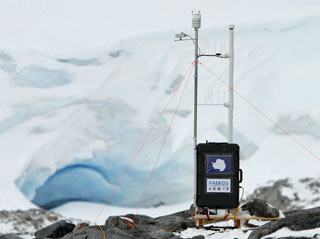
The project, based at SIO, is looking at tiny particles found in the atmosphere that are emitted from the ocean--including those produced from phytoplankton. The project was funded for one summer as a proof-of-concept and may return next season.
This intriguing photo shows its initial installation, we're looking toward the ever-receding inland end of Hero Inlet. Here's an excellent November 2013 Antarctic Sun article about the study. More information and photos are here.
Winter 2014
Manager: Bob DeValentino; population 21 (list and photos)
Brazil announces details of reconstruction of Commandante Ferraz station.
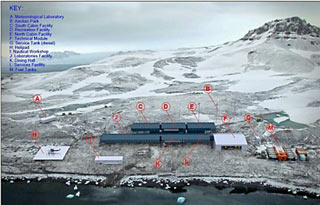
The station, which is in Admiralty Bay near Arctowski and Copacabana, was destroyed in February 2012 by a disastrous fire that killed two people (earlier coverage). This was presented at the April/May Antarctic Treaty meeting in Brasilia...here's a link to the detailed document about the station reconstruction, presented at the April/May 2014 Antarctic Treaty meeting in Brazilia. Interestingly, Ferraro Choi and Associates....the Hawaii firm that has been involved with many USAP projects, was an unsuccessful participant in the design competition.
Late season construction changes the landscape and adds boat trailers (!)
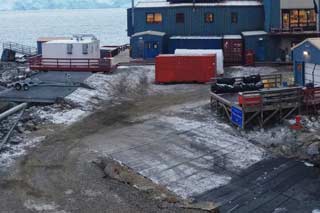
A construction crew on site in May concentrated on completing a few projects...including the new boat ramp. The milvans stored near the pier were moved, the Bat Cave (waste office) was demo'd, the function was moved to Clean Air, and the Zodiac management was improved by the introduction of a parking deck for boat trailers, more of which should show up before the end of the 2014 winter. The white vans are two chemical storage lockers...they've been there for awhile but were hidden by the milvans. This info and the photo (a clip from the home page photo) came from Bob DeValentino.
VLF antenna raised (and moved from the glacier to the backyard).
Photographic darkroom dismantled/the space repurposed.
Summer 2014-15
A collaborative research project installs multiple high-frequency radar stations.
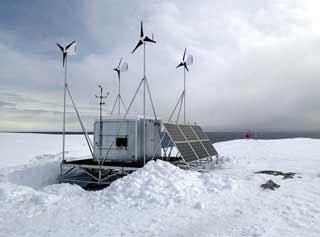
The one at left is on the Joubins...perhaps a 40-minute Zodiac trip from Palmer Station (yes, outside of the normal 2-mile boating limit). The project involves CODAR high frequency radar stations, as well as gliders, animal telemetry, and acoustics. This facility on Howard Island in the Joubins, as well as another on Wauwerman Island, of course required solar and wind power (a third site was set up in the backyard). The project would continue to be monitored by the research associate until the equipment was removed in February 2017. Check out this May 2014 Antarctic Sun article about the project, as well as the Project CONVERGE site (the photo at left is by Peter Winsor, from the November 2014 station science sitrep).
Glacier terminus measurements updated.
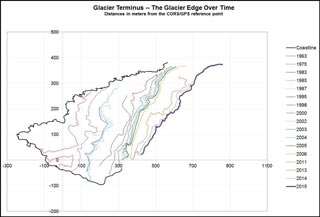
An ongoing informal project is the tracking of the edge of the glacier terminus in the backyard. The chart at left was updated by research associate Mark Dalberth for the February 2015 science report.
For comparison, here's a 24 March 2013 Worldview2 satellite image courtesy of the Polar Geospacial Center...this is from the April 2015 science report, marked up to indicate 2014-15 soil sampling locations by Andrew Klein's project team.
First prototype rigid-hull inflatable boat (RHIB) makes its appearance (March).
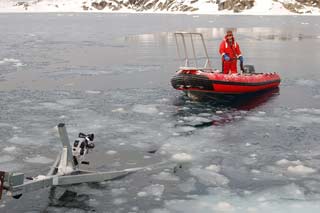
The need for RHIB's to expand the boating radius and science capabilities was one of the significant points in the Blue Ribbon Panel report. What is seen here is not the final solution...but this is a SOLAS 4-meter aluminum-hull RHIB. Note the boat trailer...that is how all boats are being launched nowadays. The larger RHIB's being procured now are too heavy to be picked up by anything on site. Seen here...Julian Race is driving, the photo is by Chuck Holloway, and some of this info is from Cynthia Spence and David Moore.
Continue to 2015-present timeline